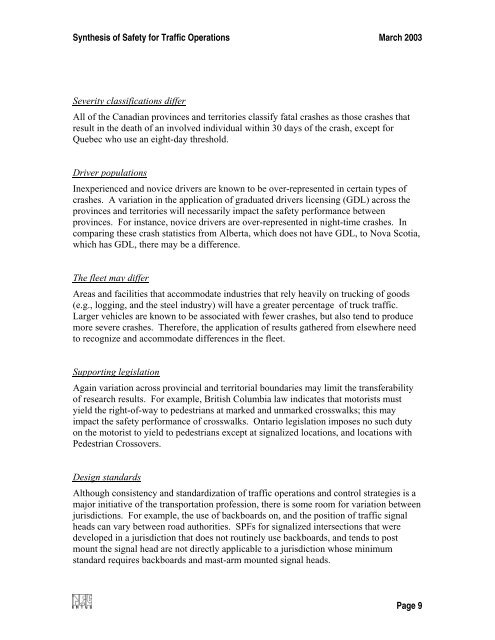Synthesis of Safety for Traffic Operations - Transports Canada
Synthesis of Safety for Traffic Operations - Transports Canada
Synthesis of Safety for Traffic Operations - Transports Canada
Create successful ePaper yourself
Turn your PDF publications into a flip-book with our unique Google optimized e-Paper software.
<strong>Synthesis</strong> <strong>of</strong> <strong>Safety</strong> <strong>for</strong> <strong>Traffic</strong> <strong>Operations</strong> March 2003<br />
Severity classifications differ<br />
All <strong>of</strong> the Canadian provinces and territories classify fatal crashes as those crashes that<br />
result in the death <strong>of</strong> an involved individual within 30 days <strong>of</strong> the crash, except <strong>for</strong><br />
Quebec who use an eight-day threshold.<br />
Driver populations<br />
Inexperienced and novice drivers are known to be over-represented in certain types <strong>of</strong><br />
crashes. A variation in the application <strong>of</strong> graduated drivers licensing (GDL) across the<br />
provinces and territories will necessarily impact the safety per<strong>for</strong>mance between<br />
provinces. For instance, novice drivers are over-represented in night-time crashes. In<br />
comparing these crash statistics from Alberta, which does not have GDL, to Nova Scotia,<br />
which has GDL, there may be a difference.<br />
The fleet may differ<br />
Areas and facilities that accommodate industries that rely heavily on trucking <strong>of</strong> goods<br />
(e.g., logging, and the steel industry) will have a greater percentage <strong>of</strong> truck traffic.<br />
Larger vehicles are known to be associated with fewer crashes, but also tend to produce<br />
more severe crashes. There<strong>for</strong>e, the application <strong>of</strong> results gathered from elsewhere need<br />
to recognize and accommodate differences in the fleet.<br />
Supporting legislation<br />
Again variation across provincial and territorial boundaries may limit the transferability<br />
<strong>of</strong> research results. For example, British Columbia law indicates that motorists must<br />
yield the right-<strong>of</strong>-way to pedestrians at marked and unmarked crosswalks; this may<br />
impact the safety per<strong>for</strong>mance <strong>of</strong> crosswalks. Ontario legislation imposes no such duty<br />
on the motorist to yield to pedestrians except at signalized locations, and locations with<br />
Pedestrian Crossovers.<br />
Design standards<br />
Although consistency and standardization <strong>of</strong> traffic operations and control strategies is a<br />
major initiative <strong>of</strong> the transportation pr<strong>of</strong>ession, there is some room <strong>for</strong> variation between<br />
jurisdictions. For example, the use <strong>of</strong> backboards on, and the position <strong>of</strong> traffic signal<br />
heads can vary between road authorities. SPFs <strong>for</strong> signalized intersections that were<br />
developed in a jurisdiction that does not routinely use backboards, and tends to post<br />
mount the signal head are not directly applicable to a jurisdiction whose minimum<br />
standard requires backboards and mast-arm mounted signal heads.<br />
Page 9
















